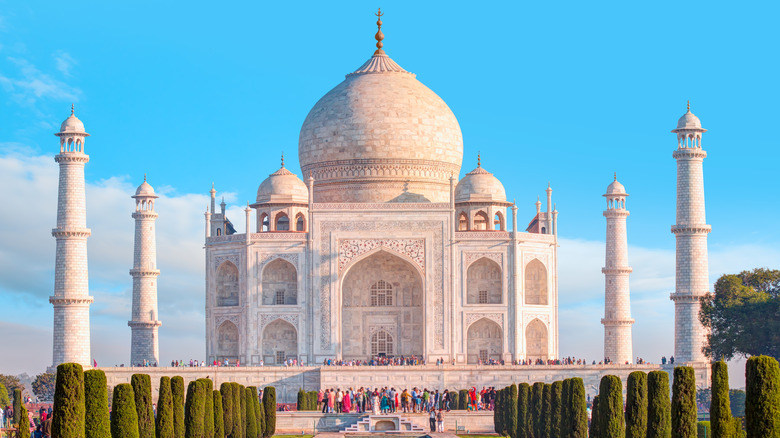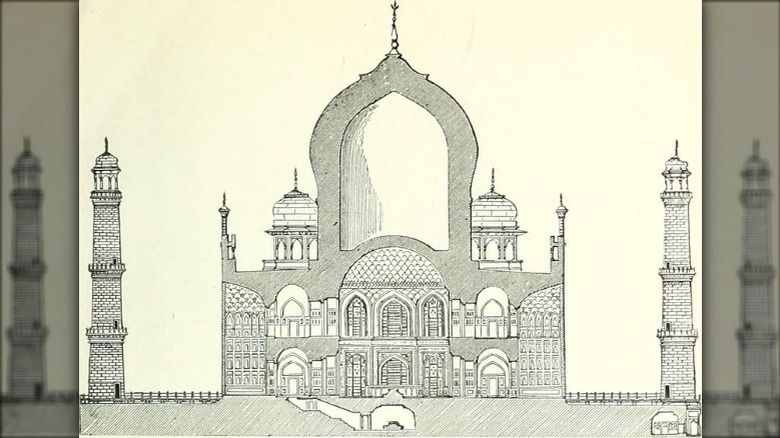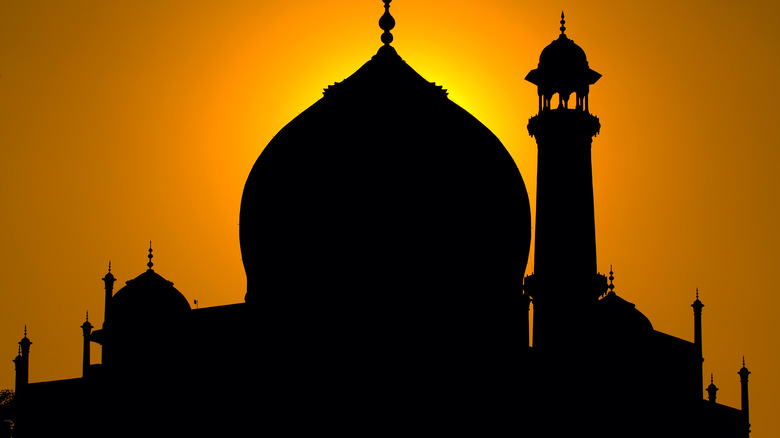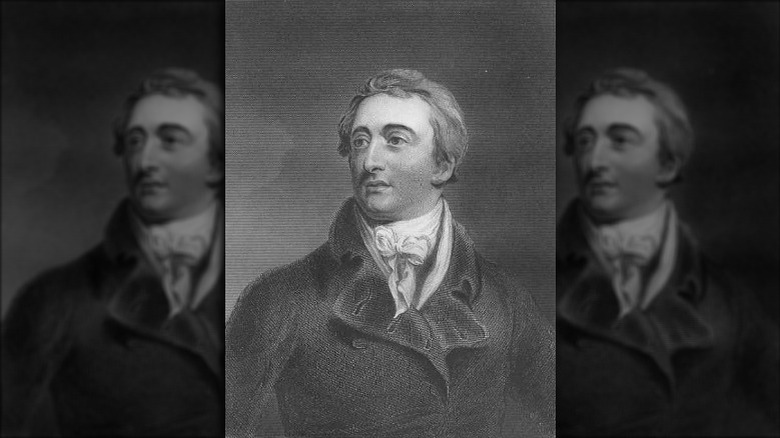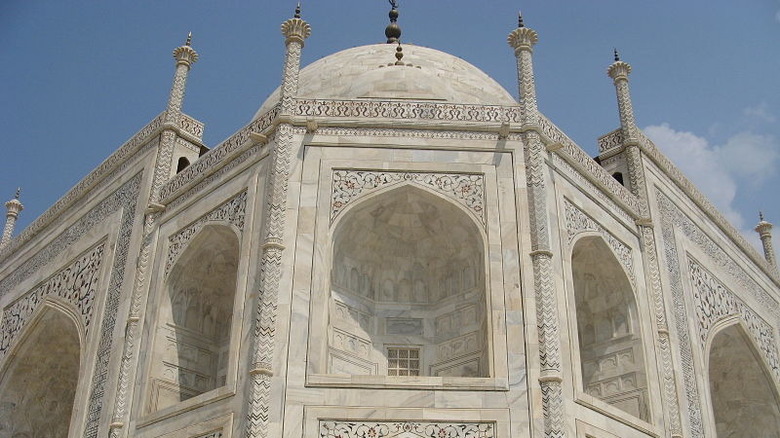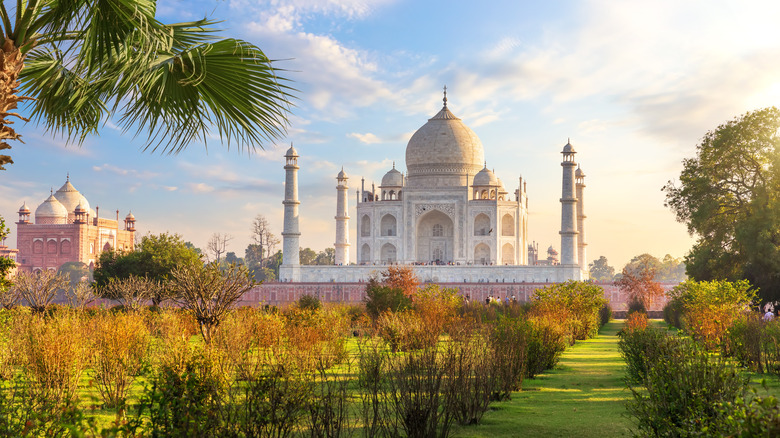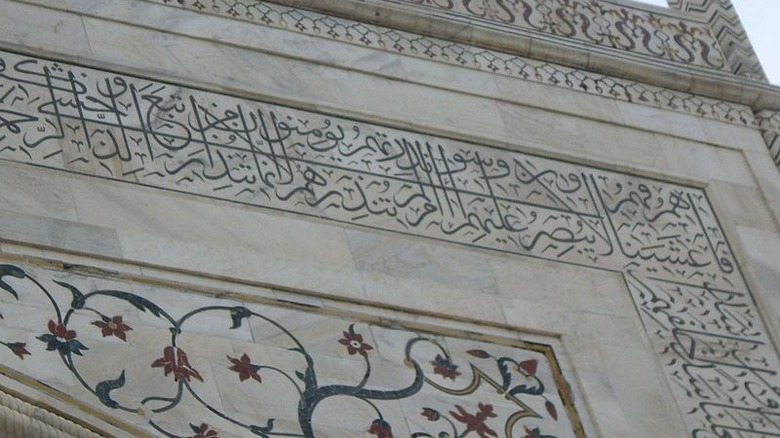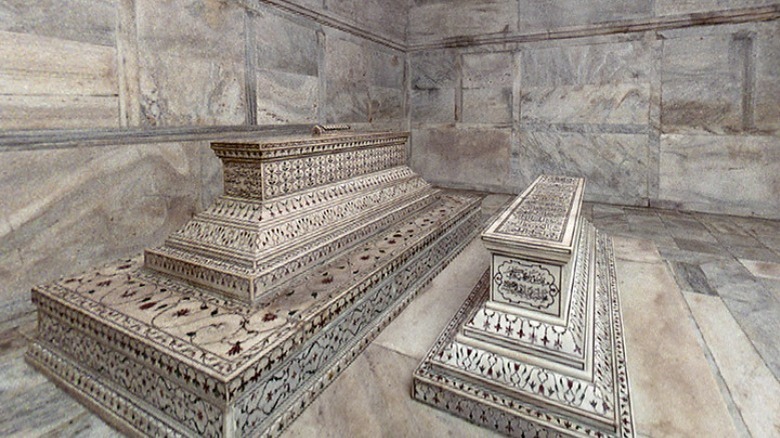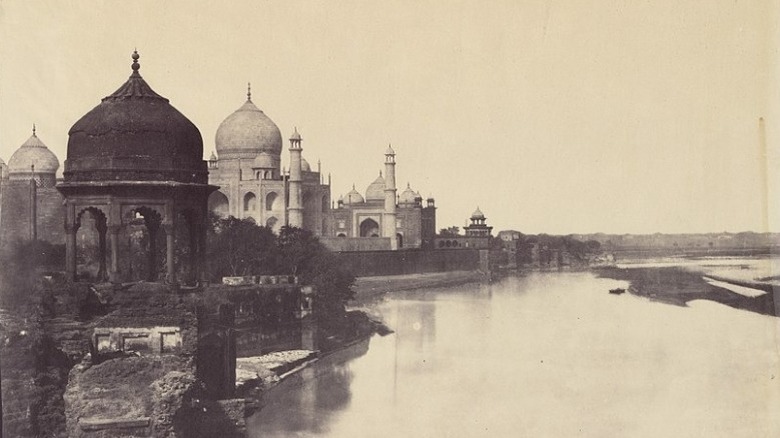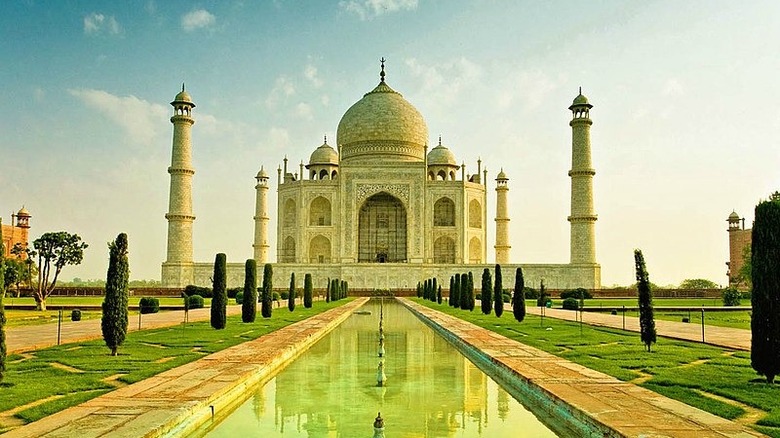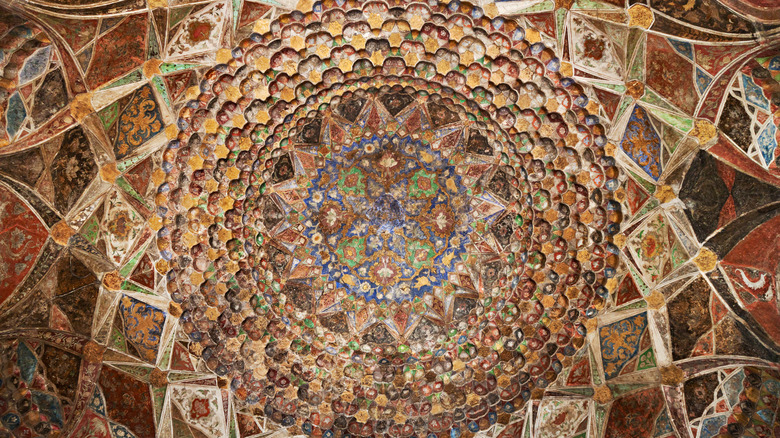False Things You've Always Believed About The Taj Mahal
The Taj Mahal is one of the most famous buildings in the world. People put going to see it on their bucket list, traveling all the way to Agra in India to get photos for the 'gram. Despite the fact it's basically just a big tomb, the final resting place of two people, it's also stunningly beautiful and exceedingly romantic.
Built by Shah Jahan to honor his favorite wife, Mumtaz Mahal, who died in 1631, the Taj Mahal is a display of love that no one is ever going to beat. It took over 20 years to complete. In modern money, it cost almost a billion dollars to construct. It's a UNESCO World Heritage Site and one of the New 7 Wonders of the World. No number of roses or diamonds can compete with a towering, ornate, gleaming white marble monument to how awesome your wife is. Sure, she wasn't exactly around to enjoy it, but it's the thought that counts. And when he died, Shah Jahan chose to join Mumtaz Mahal in the Taj, so the two would never have to be parted again. Cue the "awwwwws."
Over the past 400 years, rumors and myths about the Taj Mahal have entered the public consciousness. It's understandable; ornate tombs are the perfect targets of urban legends. But a building with such a great story already doesn't need embellishments from disinformation, so here are some false things you probably always believed about the Taj Mahal.
It was designed by an Italian architect
When the British came to India, they brought with them plenty of racist ideas about how they were so much better than the people who already lived there. This manifested itself in many horrible ways, but one, according to The Taj Tours, was that they looked at the Taj Mahal and decided there was no way the locals could have made something so awesome.
Luckily for any biased Europeans who wanted to believe one of them was really responsible for the beauty of the Taj, an Italian architect named Geronimo Veroneo did live in the vicinity around the time of the mausoleum's construction. However, he had nothing to do with it. This was probably a good thing, since the myth also says that Shah Jahan had Veroneo killed once the Taj was finished.
Shah Jahan was a great lover of architecture and probably had a hand in the planning and designs himself, but he was smart enough to know he needed a whole team of architects to help him out. That's why there isn't any one name we can point to as the designer of the Taj: there wasn't one. It was a group project. Records from the time name 37 men who were in charge of various areas of the construction, from the dome to the mosaics to the masonry to the supervisory roles. And another story even claims that Shah Jahan got the idea for the design from Mumtaz Mahal herself as she was dying.
There was supposed to be a black Taj Mahal
Sure, the Taj Mahal is gorgeous and a wonder of architecture, but for a lot of people, getting all the way to Agra is expensive and time-consuming. Is it really worth it to see just one building? But... what if there were two? Suddenly, it's doubly worth the effort!
According to the Times of India, there is a prevalent myth that Shah Jahan did not originally plan to be buried in the Taj Mahal with his wife, but in a mirror image version of it across the Yamuna River. This second Taj would have been the same in every way – except it would be completely black. The myth comes from the writings of a single guy: Jean Baptiste Tavernier. The French traveler visited Agra twice in the mid-1600s and wrote a book about his experiences. According to Tavernier, Shah Jahan wasn't just planning a black Taj, he had already started building it. A local legend embellishes this story, saying the two tombs would have been connected by a silver bridge.
You might have noticed there is no black Taj, so what happened? Tavernier said war with his own sons ruined Shah Jahan's grand plans. When archeologists found the remains of a pond and some large black marble blocks across the river from the Taj in the 1800s, it seemed the story must be true. Sadly, the marble was just white marble that had gotten dirty over the years, and the pond is from a much older garden.
The British planned to demolish the Taj Mahal
Look, no one is going to claim the British were respectful of Indians or Indian culture when they brutally colonized the subcontinent. But the myth that Governor-General Lord William Bentinck (pictured) planned on demolishing the Taj Mahal is a bit extreme, even for them. It would have been much more believable if the myth said he planned on dismantling it and shipping it back to England for display in the British Museum. That was more their style.
According to a 1949 article in The Journal of the Royal Asiatic Society of Great Britain and Ireland, the rumor was that in the 1830s, Lord Bentinck decided he could make a pretty penny selling the marble that made up the Taj. Allegedly, the only reason he didn't go through with his plan was because a "test auction" didn't go well, and it looked like he wouldn't actually make a bunch of money after all. Another source said the marble would actually have been used to build an official building in Kolkata.
The Times of India says the rumor probably started because Lord Bentinck actually did follow through with a predecessor's plans to sell the marble from a royal bath in Agra, but in that case, it was because the building was in "a decrepit condition." The East India Company's army was mad at Lord Bentinck for cutting their pay, so it's likely they spread rumors about him, including that he wanted to demolish the Taj.
Craftsmen were mutilated after they finished building the Taj Mahal
Anyone who gazes at the Taj Mahal must wonder if they will ever see anything so beautiful again. Imagine being one of the people who actually worked on building it, and being able to look at the stunning mausoleum knowing their hands helped create it. It would be the peak of those craftsmen's careers.
And, according to myth, Shah Jahan made sure everyone who worked on the Taj would never create anything better, not by giving them all money to enjoy a long retirement in gratitude for the hard work they'd done, but by making it physically impossible by mutilating them, per Lonely Planet. The TajMahal.org.uk website explains this gruesome myth in more detail: The Shah ordered the craftsmen's eyes gouged out and their hands cut off. His logic was that if they couldn't build anything else, then the Taj Mahal would never be topped.
Of course, if this were true, it would make viewing the Taj Mahal a much less enjoyable event, knowing the suffering and injustice the people who made it went through. Thankfully, you can enjoy away without feeling guilty, because there is no evidence this atrocity happened in records from the time period. Not even a random French traveler came along and wrote the story down. And the myth doesn't make much sense: surely if his craftsmen were that good, Shah Jahan would have wanted to keep them around to build him more awesome stuff?
It was originally a palace
Looking at the Taj Mahal, you can't help but think it's rather fancy for a tomb. Would someone really go to all that trouble just to bury a single person they loved? This has led to the myth that the Taj was originally built as something else. One of these stories says it was built not as a mausoleum but as a palace.
While the Taj Mahal would undoubtedly have made a cool palace, it was only ever built as a tomb. However, compounding the confusion is the fact there is another Taj Mahal in India that was a palace. It turns out, there's a building called the Taj Mahal in Bhopal, too. This one is younger, built in the late 1800s, according to the Deccan Herald. Even more confusingly, it was built by a ruler with a similar name to the ruler who built Agra's Taj: Nawab Shah Jahan Begum. (The big difference being Begum was a woman.)
So why name the newer building the same thing as the original monument? Apparently, Begum didn't. Instead, it was known as the Raj Mahal. But then, "When the British Resident called on Shah Jahan Begum, he was so impressed with its architecture that he looked around with admiration and remarked that this splendid palace should be known as the 'Taj Mahal'. After all, it is the creation of Shah Jahan Begum. Thereafter, the Raj Mahal was renamed Taj Mahal," according to an unnamed "old timer" source in DNA India.
It was originally a Hindu temple
The Taj Mahal is India's most famous building, but it was built by a Muslim ruler in what is a Hindu-majority country. This might not seem like a big deal, except that some modern politicians have decided to make it one. As a way of "reclaiming" the glory of the Taj for Hindus, a few politicians have claimed it wasn't built as a mausoleum for a Muslim ruler's wife, but only repurposed as one. Originally, so the myth goes, it was a Hindu temple.
"Taj Mahal is a Hindu temple. There are many symbols of Hindu gods and goddesses in Taj. It was known as Tejo Mahal and water used to drip from its ceiling...," BJP parliamentarian Vinay Katiyar claimed, per NDTV. "If this was only a grave then why are so many rooms built here?"
However much these individuals might want the myth to be true, it just isn't. "Recorded history proves beyond any doubt that the Taj Mahal was built by Shah Jahan in memory of his queen," historian Harbans Mukhia told the BBC. Historian Rana Safvi added it was merely the previous building on the site that belonged to a Hindu ruler. "There was a [mansion] owned by Hindu ruler Jai Singh which existed before the Taj was built there. Shah Jahan officially bought the [mansion] from him. An official [order] was issued about this and it still exists. The [order] also shows that the Mughals were very particular about recording their deeds and history," she said.
There is a secret third set of graves
If you go to the Taj Mahal and look at the tombs of Shah Jahan and his favorite queen Mumtaz Mahal, you will see they are equally beautiful to anything else in the building. Smithsonian Magazine says that the two large cenotaphs are found in an octagonal chamber, and are each covered with geometric designs, images of flowers, and semi-precious stones. They are viewed from behind a marble screen cut into a delicate lattice pattern.
Visitors who spend time gazing at the couple's side by side tombs might be shocked to learn they aren't actually in them. The ornate tombs are empty. Instead, the bodies are in tombs in a plain room (pictured) right beneath the false ones.
Or are they? Yes, they are. But a myth says that those simpler tombs are also empty, and that there is an even more secret third set of tombs that really hold the Shah and Mumtaz.TajMahal.org.uk explains that having three sets of graves was a Turkish Mughal tradition, and other famous Mughal tombs in India actually do have a third set. "Taj Mahal: Passion and Genius at the Heart of the Moghul Empire" reports that some archeologists believe a mysterious corridor underneath the Taj was used to access the real graves. While it is true the corridor exists and that no one can figure out why it's there or what it might have been used for, there's no evidence of a third set of graves.
The Taj Mahal is a building for the ages
It's almost impossible to imagine a world without the beauty of the Taj Mahal. We think of old buildings like that as made to last, and that they will be enjoyed by innumerable generations to come. Well, as the fire at Notre Dame Cathedral proved, that definitely isn't guaranteed. And in the case of the Taj, it doesn't even need a fire to be in danger of being lost forever.
According to the Economist, in 2018, India's Supreme Court ordered the government of Uttar Pradesh to "shut down the Taj or demolish it or ... restore it." And that they needed to do something to stop the "worrying change in color" from a gleaming white to yellow, green, and even black, due to decades of air pollution.
But cleaning the exterior is one thing. The very structural foundation of the building is another. The Diplomat reports that as the population of Agra grows, the increased use of water is draining the Yamuna River. Per the India Times, the river running past the Taj isn't just pretty, but integral to keeping the mausoleum standing. "Several studies have been carried out on this. There are shafts of wood holding together the foundation of the monument. This wood needs to be moistened by the river's waters to lend strength to the foundation. But the water table below the structure is depleting because of a dry Yamuna," MP Ram Shankar Katehria explained. If a solution isn't found, the Taj could be in serious danger.
The Taj Mahal is completely symmetrical
You could spend a long time looking over every inch of the Taj Mahal and come away with the belief that the building is completely symmetrical. The almost overwhelming symmetry, down to the smallest detail, is one of the things that makes the building so striking. However, some experts actually have looked at every little bit, and it turns out that there are a few glaring areas that are not at all symmetrical.
The most obvious, even to the casual viewer, are the graves themselves, according to Mental Floss. While Mumtaz Mahal's tomb is in the direct center of the crypt, Shah Jahan's is off to the side of hers. This might be simply down to the fact his was only added after he died, and was not part of the original building design.
But an even bigger unsymmetrical bit is one you've seen a million times and never noticed: the massive dome itself, which is "tilted from the vertical axis." Why? "Three possible conjectures present themselves. One, that it was an intentional error. Second, the deformation did not exist at the beginning but became accentuated over time, and third, it was a construction error that has existed from the beginning," researchers from the National Institute of Advanced Studies explained (via the Bangalore Mirror). It's thought the third explanation is the most likely, because "it is an outer dome constructed after the inner dome was finished and therefore perhaps the builders did not have the benefit of a central plumb line."
A hole was left in the ceiling as a sign of disrespect
The Taj Mahal might look like a perfect building, but anything on that grand a scale is going to have issues, regardless of how talented the people who built it were. One imperfection, however, is rumored to have been included on purpose, and meant as a sign of disrespect to Shah Jahan himself.
According to the Daily Bangladesh, there is a small hole in the roof of the main chamber, said to be directly over Mumtaz Mahal's tomb. A worker allegedly put the hole there to ruin Shah Jahan's goal of a perfect monument to his wife once he found out all the craftsmen were going to have their hands cut off when the building was finished. Well, considering the craftsmen weren't mutilated, there would be no reason to do this.
Furthermore, a letter from Prince Aurangzeb to Shah Jahan (via the Times of India) reveals that issues with the Taj were discovered almost immediately: "The dome of the holy tomb leaked in two places towards the north during the rainy season and so also the fair semi-domed arches, many of the galleries on the second story, the four smaller domes, the four northern compartments and the seven arched underground chambers which have developed cracks ... During the rains last year, the terrace over the main dome also leaked in two or three places." There was no need to sabotage the "perfect" building, because it was always going to be impossible to make one.
